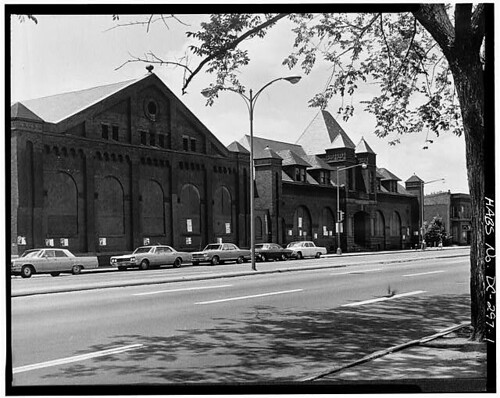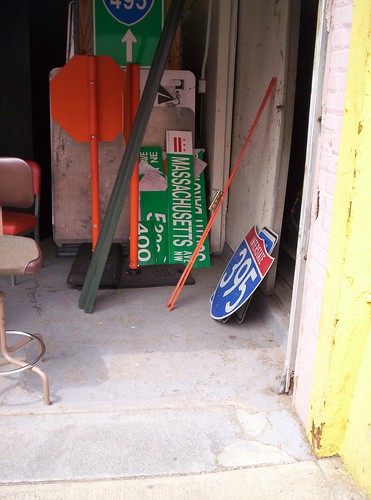I was wrong: a streetcar car barn probably shouldn't be built on the grounds of Spingarn High School
I have blogged (I think) and written on listservs and such that putting a streetcar barn on the Spingarn campus wouldn't be a bad thing, after all, there used to be a trolley car barn a few blocks west on Benning Road through the 1970s.
Also see "Gray Backs Ward 5 Streetcar Car Barn Location, Says Seven to 10 Will Be Needed for Whole System" from DCist--and 7-10 facilities seems like overkill to me. Why is it that Portland so far gets by with one, last time I was there it was situated under a freeway overpass.)
An email discussion with a Ward 5 activist made me reconsider my position.
 Right: the old trolley barn on Benning Road was demolished in the 1970s. Above, rendering for a streetcar barn on the grounds of Spingarn High School.
Right: the old trolley barn on Benning Road was demolished in the 1970s. Above, rendering for a streetcar barn on the grounds of Spingarn High School.1. While it's true that the old streetcar barns can be attractive--one on East Capitol is a condominium, the Blue Castle across from the Navy Yard will eventually be redeveloped, one is an office building in Georgetown, and the facility on upper 14th Street NW is still in use--the likelihood of facilities to be constructed these days being attractive is lower, at least compared to the late 1800s.
2. And the grounds of Spingarn campus, while underutilized and undermaintained, are attractive.
And if we ever get back to the proposed Spingarn campus plan from the early part of last decade where a U of Michigan design studio had many proposals including integrating housing and other uses into the largely underutilized campus, having a streetcar barn plopped there right at Benning Road might not make sense from that standpoint.
3. I think there are two options. One is to build it on the RFK Parking lots proximate to Benning Road, as part of a long term redevelopment of the site. (See the past blog entry "Wanted: A comprehensive plan for the "Anacostia River East" corridor.")
A problem with this idea is that it couldn't happen quick. It would require permission from the National Park Service and likely long negotiations. And the point I make a redoing the stadium complex will require another long process and payments to the National Park Service to extinguish the equivalent of a recreation easement on the property.
If it were built on the RFK lots, it could be built as an attractive building that's visible and prominent like the streetcar barns of old or it could be built in a manner where it could be surrounded later by other development, which hides the use.
This was typical of how service uses like stables, small manufacturing and service facilities, auto repair, and such were integrated into inner cities, by placing them on the interior of blocks, accessible by alleys.
 There aren't many instances of this today.
There aren't many instances of this today. However, DC DPW and DDOT, along with other private sector uses have some facilities in Eastern Capitol Hill that are located in an alley complex where the buildings are on the interior and the face of the block has housing on it--between 13th, 14th, E, and G Streets SE (pictured above). The Post wrote about it here, "Seeing to Nats Fans' Vital Signs." From the article:
Established in the late 1930s, the sign shop is responsible for designing, manufacturing and installing practically all of the street signs in the District, including federal signs. Tucked away in a nondescript alley off Pennsylvania Avenue and G Street Southeast, the shop is always busy with a staff of 30 -- 9 fabricators, 18 installers and 3 stock workers who keep track of supply.
4. The old Pepco electricity plant is shut down and eventually the site will be redeveloped. It's zoned industrial and a streetcar shop (like the big bus yard and maintenance facility on Bladensburg) is fundamentally an industrial use. Why not put a streetcar barn there, even as a temporary use in the interim, to provide more time for a more permanent solution?
Yes it will be harder and will require negotiation and payment, unlike the pre-existing DC owned site of the Spingarn campus--this is the likely motivation for the use of this site, expediency and cost--but from the standpoint of positioning the Spingarn campus and the Benning Road corridor for long term revitalization, such a choice would make more sense.

Benning Road Pepco Site.
Labels: transit infrastructure, transportation planning, urban design/placemaking, urban revitalization







1 Comments:
Hello dear guys,
The area and neighborhood is the most important thing to consider when building a laundromat business.The best laundromats in Toronto are as hard to find as a missing sock. There are thousands of them in the city, and most are destined to ruin your clothes sooner or later (probably sooner). But laundromats force us into the uneasy choice of convenience over quality, so we take our chances with unreliable washers and unclean dryers simply because we can walk over to the place in our pyjamas.Read more at-:24 hour Toronto coin laundromat
Post a Comment
<< Home